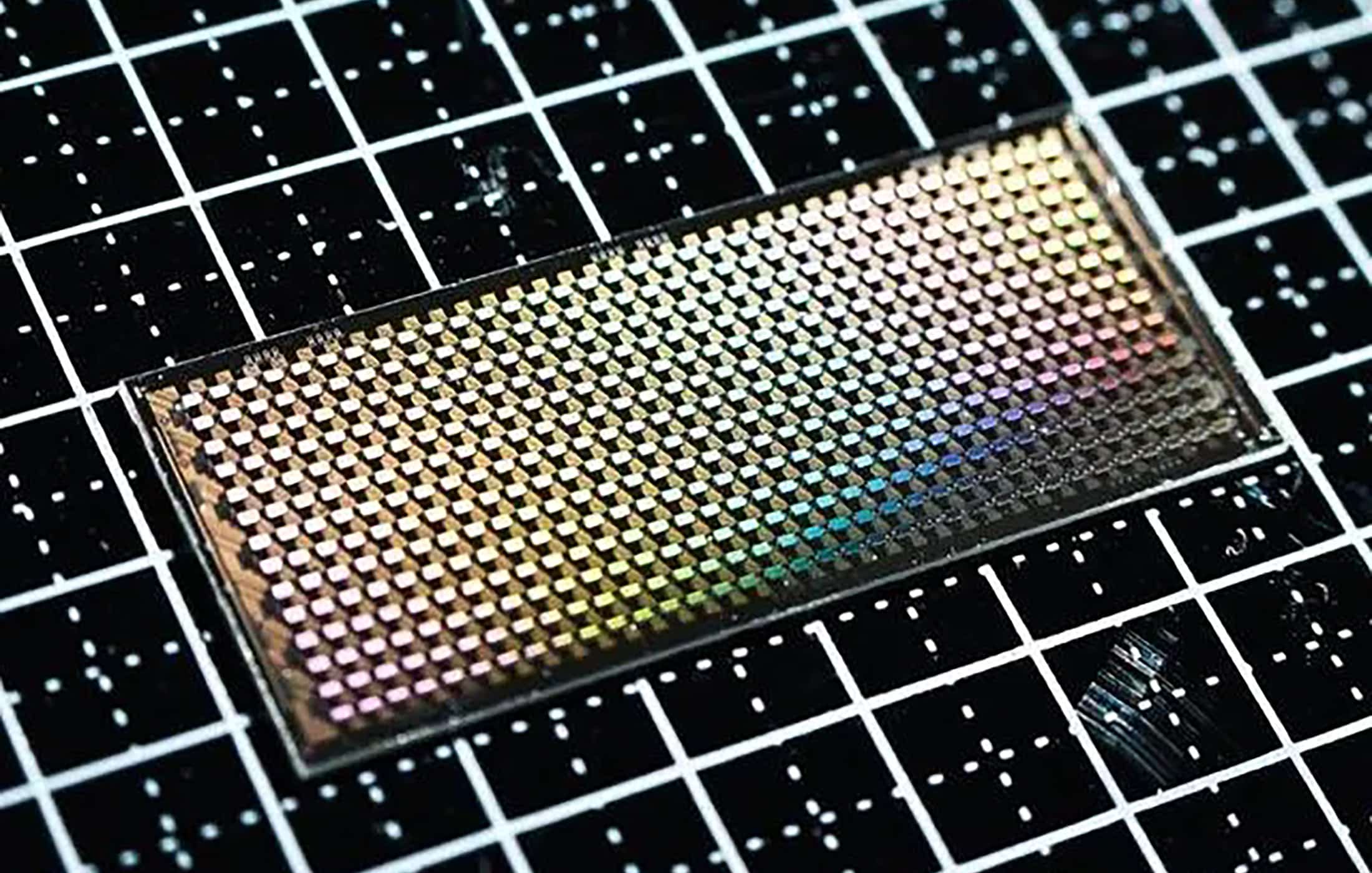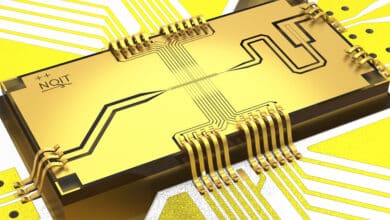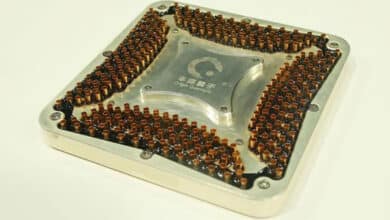China Unveils Xiaohong: A 504-Qubit Processor

Table of Contents
Hefei, China (April 2024) – Chinese researchers have announced “Xiaohong”, a new superconducting quantum processor boasting 504 qubits – the largest such chip ever built in China. This record-breaking processor, developed by the CAS Center for Excellence in Quantum Information and Quantum Physics in collaboration with industry partner QuantumCTek, vaults China into the upper echelon of quantum hardware achievements. Xiaohong’s qubit count surpasses previous domestic efforts by an order of magnitude, marking a significant milestone in the nation’s quest for quantum computing leadership. Just as importantly, the team reports that the chip’s quality metrics (qubit coherence lifetimes, gate fidelities, and usable circuit depth) are expected to rival those of leading international platforms like IBM’s quantum machines. In other words, Xiaohong is not only bigger, but also aims to be better in reliability – a critical combination as the global quantum race accelerates.
A New Milestone for China’s Quantum Computing Ambitions
The unveiling of Xiaohong represents a major leap forward for China’s superconducting quantum computing program. With 504 quantum bits (qubits) on a single chip, Xiaohong crosses the long-anticipated “500+ qubit” threshold, demonstrating China’s ability to scale up quantum processors into the hundreds of qubits. For context, the country’s previous record-holder was the Zuchongzhi 2.1 processor with 66 qubits, debuted in 2021. In the years since, Chinese researchers rapidly expanded their designs – from 66 qubits to 176 qubits by 2023, when an upgraded Zuchongzhi system was put online for public use. Now Xiaohong pushes the frontier further to 504 qubits, roughly tripling the scale of China’s last-generation superconducting chips.
This achievement is not just about raw numbers. Notably, the Xiaohong project focuses on building the infrastructure needed for next-generation quantum computers. The 504-qubit chip was delivered to QuantumCTek – a leading quantum technology company in Anhui Province – as a test platform for a new “kilo-qubit” control system. In a superconducting quantum computer, the measurement and control system (the complex electronics that manipulate and read out qubits at cryogenic temperatures) is just as crucial as the qubits themselves. Scaling to hundreds or thousands of qubits poses enormous engineering challenges: more microwave control lines, more sources of noise, and intricate calibration demands. Xiaohong is being used to verify that QuantumCTek’s independently-developed control hardware can handle a 1,000-qubit scale system. In that sense, Xiaohong is a stepping stone to even larger machines. “The measurement and control system will greatly influence the overall performance of quantum computers,” explains Liang Futian, associate professor at the CAS center, underscoring why this chip is so important for refining the supporting technology.
Despite its impressive scale, Xiaohong is not about immediately breaking computing records or achieving “quantum supremacy” again. Gong Ming, a researcher on the project, emphasized that the primary goal is to enable large-scale quantum computing through better hardware, “rather than to aim for higher computing power and quantum supremacy” with this chip. In practical terms, that means the team is less concerned with running some specific algorithm faster than a classical supercomputer (the bar for quantum computational advantage) and more concerned with learning how to build and control quantum processors at scale. Qubits are notoriously fragile – they easily lose their quantum state (decohere) from the slightest disturbances, and they introduce errors in computations. By pushing to 504 qubits and benchmarking its performance, the Chinese team can identify engineering solutions for stability, crosstalk, and error correction that will be vital for future machines. As one analysis noted, Xiaohong “is not a computer per se” but a testing platform for the large-scale measurement and control techniques needed to tame so many qubits. This kind of foundational work is critical because, as quantum engineers often remind us, simply adding more qubits is futile unless you can keep them all under precise control.
From Zuchongzhi to Xiaohong: Rapid Progress in Qubit Count
Xiaohong’s debut comes on the heels of a series of rapid advances by China in superconducting quantum hardware. To appreciate how far things have come, it’s worth looking at the quantum chip milestones achieved in the past few years:
- Zuchongzhi 1.0 (2021) – A 62-qubit superconducting processor, one of China’s first large-scale quantum chips. In May 2021, this prototype was used to demonstrate two-dimensional quantum walks, an experimental validation of multi-qubit operations on a programmable device. It set the stage for more ambitious experiments.
- Zuchongzhi 2.0/2.1 (2021) – By the fall of 2021, the USTC**(University of Science and Technology of China)** team led by Pan Jianwei had improved their design to 66 qubits, dubbed Zuchongzhi 2.1. With enhanced fidelity (readout accuracy ~97.8%), this system performed random quantum circuit sampling at a scale and speed beyond the reach of any classical supercomputer. In other words, it achieved a quantum computational advantage – often called “quantum supremacy” – via superconducting qubits, making China the first nation to reach that landmark in two different technologies (superconducting and photonic). In one benchmark, Zuchongzhi 2.1 could sample quantum circuits about 10 million times faster than the fastest classical supercomputer, a staggering speedup that confirmed the power of the 66-qubit device.
- Jiuzhang 2.0 (2021) – In parallel, another Chinese team achieved quantum advantage using light instead of superconductors. The Jiuzhang 2.0 photonic processor detected 113 photons in a specialized computation, reinforcing China’s unique status as the only country to demonstrate quantum advantage on two fronts. (This photonic approach is a separate line of research, but it underscores the broader quantum progress in China.)
- IBM Eagle (2021) – For comparison, IBM in 2021 unveiled Eagle, a 127-qubit superconducting processor, becoming the first to break the 100-qubit barrier in a single chip. Eagle’s debut highlighted new techniques (like advanced 3D packaging to route control wiring) and was a milestone for the industry globally, roughly doubling the qubit count of prior devices.
- IBM Osprey (2022) – The following year, IBM launched Osprey, a 433-qubit processor, leapfrogging its own record by over 3×. Osprey dramatically raised the bar for qubit counts in a functional quantum computer, and IBM noted it as a step toward their planned 1000+ qubit machines. By late 2022, Osprey’s 433 qubits stood as the largest gate-based quantum processor in the world, signaling IBM’s aggressive roadmap.
- Zuchongzhi 3.0 (2023) – Not to be outdone, the CAS/USTC team continued refining their processors. In 2023 they revealed a new prototype, often called Zuchongzhi 3.0, with over 100 qubits operating at very high fidelity. In fact, the researchers reported 105 effective qubits with single-qubit gate fidelities of 99.9% and two-qubit gates at 99.6% – quality on par with the best of IBM and Google. By adding additional coupling interfaces, they extended the system to allow control of 176 qubits, and put this 176-qubit quantum computing platform online for users to experiment with in mid-2023. This move toward cloud access showed an increasing maturity: even as the hardware scaled up, it was made available to external developers, much like IBM’s quantum cloud offerings.
- Origin Quantum’s Wukong (2023) – China’s growing quantum ecosystem also saw contributions from startups. In January 2024 (late 2023 development), Hefei-based startup Origin Quantum announced Wukong, a 72-qubit superconducting quantum computer that was made available on the cloud. While smaller in qubit count, it demonstrated that multiple Chinese groups are now building advanced quantum chips, fostering healthy competition and innovation domestically.
This rapid progression – from tens of qubits to over five hundred – culminates in the arrival of Xiaohong. At 504 qubits, Xiaohong comfortably surpasses IBM’s 433-qubit Osprey which previously held the qubit-count crown in the superconducting realm. It also dwarfs earlier machines like Google’s 53-qubit Sycamore. Sycamore was the chip that famously achieved the first quantum supremacy demonstration in 2019, performing a random circuit computation in 200 seconds that was estimated to take 10,000 years on the fastest supercomputer at the time. That feat was accomplished with just 53 high-quality qubits – underscoring that qubit quality and algorithm design can matter as much as quantity. Now, with Xiaohong, China has a device nearly ten times larger in qubit count than Sycamore, and attention will turn to what it can do and how well it can do it.
How Xiaohong Stacks Up Against Google and IBM
In the global context, Xiaohong puts China very much in the race with the leading quantum computing players. Google and IBM have taken somewhat divergent approaches in recent years: Google’s focus has been on improving qubit fidelity and error correction techniques, while IBM has put emphasis on steadily increasing qubit counts alongside incremental improvements in quality. Until early 2024, IBM’s Osprey chip (433 qubits) was the highest-count gate-model processor reported. Xiaohong edges past that benchmark, becoming one of the world’s most advanced quantum chips by sheer qubit number. IBM, for its part, has a roadmap to unveil a ~1,121 qubit processor (codenamed Condor) as soon as 2024, and is exploring modular architectures to link multiple chips in a Quantum System Two for scaling beyond that. In other words, the 1000-qubit era is on the horizon from multiple fronts. Xiaohong affirms that China will be a player at that level, not just a spectator.
It’s important to note, however, that comparing quantum processors is about more than just qubit count. Qubit quality – coherence time, error rates, connectivity – varies between designs, and these factors determine what each quantum computer can actually accomplish. Google’s original Sycamore (53 qubits) had very high-fidelity operations, enabling that landmark supremacy experiment. IBM’s Eagle and Osprey chips introduced new engineering to maintain reasonable coherence even as qubit numbers grew into triple digits. In the case of Xiaohong, the Chinese team is confident that despite the large qubit array, they can achieve performance parity with the best international platforms on key metrics like qubit lifetime and gate fidelity. In fact, Liang Futian stated that Xiaohong’s design targets those same benchmarks that IBM’s cloud-based quantum machines have demonstrated. If those claims hold true in practice, it means China has managed to scale up without a severe loss in qubit quality – an impressive feat indicating a high level of mastery in quantum chip fabrication and cryogenic engineering.
Another aspect of Xiaohong’s significance is the accessibility it promises. China Telecom’s Quantum Computing Group (CTQG) has been working with the CAS researchers and QuantumCTek to integrate these advancements into a usable system. The Xiaohong chip is slated to be the heart of a new superconducting quantum computer called “Tianyan-504”, which will be connected to CTQG’s Tianyan quantum cloud platform. Once online, this would let users around the world run experiments on the 504-qubit processor via the cloud, similar to services offered by IBM Quantum and Amazon Braket. In fact, even before Xiaohong, the Tianyan cloud (launched in late 2023) was already hosting smaller quantum processors and had attracted over 12 million visits from 50+ countries. By making Xiaohong accessible globally, China is signaling that its quantum hardware is not just a lab curiosity but a resource for the wider community. This move could spur more comparative research – for example, developers might benchmark algorithms on Xiaohong vs. IBM’s 433-qubit system to see how they differ in practice. It’s also a step toward building a user base and developer ecosystem around Chinese quantum technology, which has strategic importance in the long run.
Technical Advances Under the Hood – and Why They Matter
Reaching 504 qubits on a single chip is an extraordinary engineering challenge. Superconducting qubits (typically implemented as tiny Josephson junction circuits) must be fabricated with nanometer precision and kept at millikelvin temperatures. Even then, qubits are unstable – they can maintain quantum states only for tens of microseconds, and each qubit operation (gate) has a probability of error. Scaling from the 66 qubits of Zuchongzhi 2.1 to the 504 of Xiaohong likely required significant innovations in chip design, fabrication, and packaging. IBM’s prior work offers some hints: when moving to 127 qubits in Eagle, IBM had to engineer a way to place control wiring on multiple chip layers to avoid crowding, and introduced through-silicon vias to route signals without disrupting the qubit layout. The Chinese team likely had to implement similar advanced techniques to deal with the “wiring bottleneck” – 504 qubits might need thousands of control and readout lines, which is a herculean task in a cryostat. It’s plausible that Xiaohong uses a two-dimensional grid of qubits (much like its 66-qubit predecessor which was an 11×6 array) with improved crosstalk isolation and perhaps modularized control circuitry. While the exact chip architecture hasn’t been publicly detailed, the achievement suggests that Chinese engineers can now manufacture and assemble quantum processor dies at scale, with complexity on par with the most advanced semiconductor chips (albeit with very different technology).
Crucially, the Xiaohong project is pushing forward the quantum control electronics needed for large systems. At 500+ qubits, even tasks like qubit calibration (tuning each qubit’s frequency, coupling strengths, etc.) become exponentially more complex. The stated purpose of Xiaohong – to validate a kilo-qubit control system – implies progress in automation and stability of these controls. For instance, the system must deliver microwave pulses to hundreds of qubits with precise timing and phase, while simultaneously reading out quantum states with high fidelity. Any small error can cascade when so many qubits are involved. The fact that researchers are confident enough to integrate Xiaohong into a cloud-accessible computer suggests that they have developed robust software and hardware to manage this complexity. In the broader quest for useful quantum computing, these kinds of “plumbing” advancements are just as pivotal as adding more qubits. They pave the way toward error-corrected quantum computing – where thousands of physical qubits might act together as one logical, fault-tolerant qubit. Although Xiaohong itself does not implement a full error-correction system, learning to handle 504 physical qubits is an essential trial run for the era when we will manipulate thousands or millions of qubits for practical algorithms.
Another technical aspect to watch with Xiaohong is its coherence and fidelity scaling. The team’s goal was to maintain key performance indicators at levels comparable to IBM’s platforms (IBM’s smaller systems generally boast >99% gate fidelities). If Xiaohong meets those targets, it means the error rate per qubit did not explode as the system grew. This could be due to improvements like better isolation of qubits from environmental noise, symmetric chip layouts that reduce interference, or more precise fabrication to minimize frequency crowding and defects. It might also reflect improvements in materials – superconducting qubits are sensitive to microscopic material defects and surface impurities. Top labs (Google, IBM, USTC) have been iterating on better materials for years. A high-performing 504-qubit chip would indicate that the Chinese group has solved many materials and design challenges at scale. That would be a tremendous technical win, since it took the field roughly two decades to go from a few qubits to ~50, but only a couple more years to leap into the hundreds – provided quality can be upheld.
In summary, Xiaohong matters not because anyone tomorrow will run a commercially useful problem on a 504-qubit NISQ (Noisy Intermediate-Scale Quantum) device – they won’t, given the noise and lack of error correction – but because it cements the engineering foundations for the next generation of quantum computers. It’s a bit like the early days of classical supercomputers: reaching a new scale (say, teraflop computing) often didn’t yield immediate practical applications, but it demonstrated the feasibility and spurred the creation of tools and techniques that would later prove invaluable. Here, Xiaohong demonstrates that half-a-thousand superconducting qubits can be controlled in one system. The lessons learned will inform designs of the coming 1,000+ qubit machines, whether it’s IBM’s Condor, Google’s next processor, or China’s own future endeavors.
Broader Implications: The Quantum Computing Race and Security Concerns
Beyond the technical sphere, Xiaohong’s launch carries broader implications for the quantum computing industry and even cybersecurity. It underscores how intense the global competition in quantum computing has become. The United States – led by firms like Google, IBM, and startups – has made rapid strides, but China’s latest achievements show a determination to keep pace or even surge ahead in certain areas. As of early 2024, experts noted that U.S. teams had a lead in some metrics (especially in demonstrated error-correction progress), but the gap can evolve quickly. With Xiaohong, China is signaling that it can innovate at scale and is serious about building an ecosystem (from state-funded labs to spinoff companies like QuantumCTek and Origin Quantum). This could fuel a healthy rivalry that accelerates progress on both sides – a modern space race, but in the quantum realm. Globally, more high-qubit devices being available via the cloud (IBM, Amazon, Google, and now Tianyan in China) means more researchers can experiment with algorithms, hopefully leading to new breakthroughs in quantum software and techniques.
For the tech industry, one immediate implication is the potential for new applications and research using these powerful quantum machines. While noisy 500-qubit processors can’t crack all problems, they might be able to explore complex quantum simulations (like modeling novel materials or quantum chemistry problems) beyond the reach of 50- or 60-qubit devices. Industries from pharmaceuticals to finance are watching quantum hardware developments closely, because as devices scale up, previously intractable problems (such as certain optimization or sampling tasks) could become solvable. The availability of Xiaohong through a cloud service will allow companies and researchers worldwide to test their quantum algorithms on one of the largest processors to date. This democratization of access could spur collaborative research – for example, a university team outside China might use the Chinese processor to run an experiment that they couldn’t on smaller machines, contributing to scientific knowledge (and incidentally, showcasing China’s hardware).
On the cybersecurity front, ever since quantum supremacy was first demonstrated, there has been heightened concern about quantum computers eventually breaking modern cryptography. The logic is straightforward: a sufficiently large and error-corrected quantum computer could run Shor’s algorithm to factor large integers, undermining RSA and other encryption schemes that secure our digital communications. Does Xiaohong bring us significantly closer to that reality? In truth, not immediately – Xiaohong is a noisy prototype, and using it to factor even a modestly large number would be hopeless with current error rates. Experts estimate that breaking strong encryption will require a fault-tolerant quantum computer with thousands of logical qubits, which might correspond to millions of physical qubits with today’s error correction overhead. At 504 physical qubits, we are still far from that regime. However, the steady march of progress embodied by Xiaohong is exactly what keeps cybersecurity experts vigilant. Each new milestone – 50 qubits, 66 qubits, 127, 433, now 504 – is a step on a roadmap that could plausibly lead to a cryptographically relevant quantum computer in a decade or more. Governments and companies are already investing in post-quantum cryptography (quantum-resistant encryption algorithms) to get ahead of this threat. China’s dual focus on quantum computing and quantum communication (e.g. satellite-based quantum key distribution) shows it is aware of the strategic importance. For now, Xiaohong poses no direct threat to encryption, but it is a reminder that the quantum era is approaching, and with it the need to future-proof our security infrastructure.
Outlook
The announcement of Xiaohong is big news – both literally, in that 504 qubits is a big number, and figuratively, in what it signifies for China’s technological trajectory. It highlights how far Chinese researchers have come in a relatively short time, from demonstrating quantum advantage on a 66-qubit device in 2021 to engineering a 504-qubit chip just a few years later. The Xiaohong project emphasizes doing the hard homework of scaling up control systems and maintaining performance, which will pay dividends as the field pushes toward truly useful quantum computers. There’s a sense of cautious optimism in the quantum community – each new device like this is an opportunity to test algorithms, discover unforeseen challenges, and refine the art of quantum engineering.
In the coming months, all eyes will be on how Xiaohong performs. Will it achieve the promised fidelities at scale? Will researchers use it to run any novel 500-qubit experiments (even of the “toy problem” variety) that show the unique physics of such a large quantum system? And how will competitors respond – for instance, will Google or IBM unveil an even larger chip or demonstrate a new level of error-corrected qubit? One thing is certain: the pace of progress in quantum computing is accelerating, and Xiaohong has added more fuel to the fire. As a tech landmark, it will be remembered as China’s first foray into the 500+ qubit realm and a crucial step toward the era of practical quantum computers. For a tech-savvy audience watching this space, developments like Xiaohong aren’t just incremental news – they are harbingers of the computational revolution on the horizon, one which promises to transform computing as profoundly as the transition from vacuum tubes to silicon transistors did in the past.



